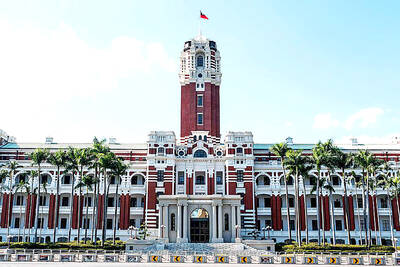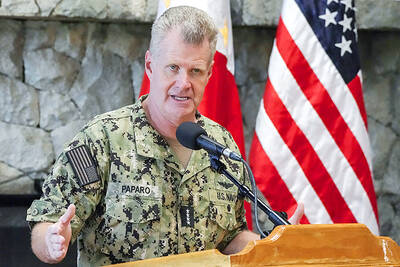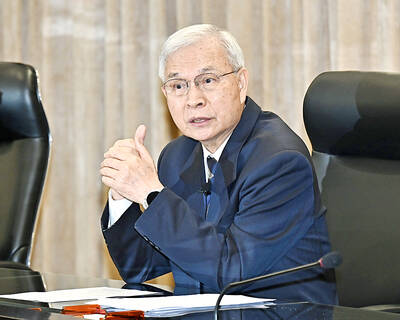The US Monday came down squarely against any attempt to change the name of Taiwan's semi-official presence in Washington from the Taipei Economic and Cultural Representative Office (TECRO) in the US, saying any change would alter Taiwan's status quo, which would run afoul of a basic tenet of the Bush administration's policy toward Taiwan.
State Department Spokesman Adam Ereli expressed the administration's unhappiness with the proposed name changes in response to statements by President Chen Shui-bian (
"These changes of terminology for government-controlled enterprises or economic and cultural offices abroad," Ereli told reporters in his daily press briefing, "in our view, would appear to unilaterally change Taiwan's status, and for that reason, we're not supportive of them."
"The United States has an interest in maintaining stability of the Taiwan Strait," Ereli asserted. "And we are, therefore, opposed to any unilateral steps that would change the status quo."
Responding to Ereli's statement, former American Institute in Taiwan chairman Nat Bellocchi conceded that a name change for TECRO "could come closer to sovereignty issues" than any changes in the names of state-controlled corporations, which are an internal affairs.
As a result, the Chen administration should "proceed carefully" with any plans for such name changes, said Bellocchi, who was AIT chairman from 1990 to 1995.
Taiwan's office in Washington was set up in 1979, after the Carter administration switched official diplomatic recognition of China from the Chinese Nationalist Party (KMT) regime in Taipei to the People's Republic of China in Beijing.
It was then called the Coordination Council for North American Affairs (CCNAA), and was created under the Taiwan Relations Act that established the unofficial US-Taiwan ties that continue to this day.
The name of CCNAA was changed to its current name, usually referred to as TECRO, in 1994, under a Taiwan policy review conducted that year by the Clinton administration. Under TECRO are 12 other Taiwan offices in various US cities, which were and are called Taipei Economic and Cultural Offices (TECO).
TECRO acts as the unofficial Taiwan embassy in Washington, and its head is regularly referred to as "ambassador" by individuals and members of Congress alike, although most government officials shun that title.
Within a year after CCNAA was changed to TECRO, supporters of Taiwan in Congress began attempts to change the name again, to the Taiwan Representative Office.
A bill authorizing State Department programs for the fiscal years 1996 and 1997 contained a provision making such a change. The bill was passed by both the House and Senate, but President Bill Clinton vetoed it for a wide variety of reasons, and Congress failed to override the veto.
One of the reasons for his decision, Clinton said in his veto message, was a provision that would amend the Taiwan Relations Act to state that it superceded the 1982 third joint communique, which called for the eventual reduction in US arms sales to Taiwan.
The communique was "one of the cornerstones of our bipartisan policy toward China" and the provision would "complicate, not facilitate" US-China relations," Clinton said in his veto message. He did not raise any objection to the provision to change the name of TECRO, however.
Even Wyoming Republican Senator Craig Thomas, then the chairman of the East Asia and the Pacific subcommittee who was supportive of better ties with China, in a floor speech before the veto, conceded that, "I fail to see how this simple [TECRO] name change can cause so much consternation."
Also see stories:
DPP caucus defends name-change plan
Airline, other firms resistant to name change proposal

The CIA has a message for Chinese government officials worried about their place in Chinese President Xi Jinping’s (習近平) government: Come work with us. The agency released two Mandarin-language videos on social media on Thursday inviting disgruntled officials to contact the CIA. The recruitment videos posted on YouTube and X racked up more than 5 million views combined in their first day. The outreach comes as CIA Director John Ratcliffe has vowed to boost the agency’s use of intelligence from human sources and its focus on China, which has recently targeted US officials with its own espionage operations. The videos are “aimed at

STEADFAST FRIEND: The bills encourage increased Taiwan-US engagement and address China’s distortion of UN Resolution 2758 to isolate Taiwan internationally The Presidential Office yesterday thanked the US House of Representatives for unanimously passing two Taiwan-related bills highlighting its solid support for Taiwan’s democracy and global participation, and for deepening bilateral relations. One of the bills, the Taiwan Assurance Implementation Act, requires the US Department of State to periodically review its guidelines for engagement with Taiwan, and report to the US Congress on the guidelines and plans to lift self-imposed limitations on US-Taiwan engagement. The other bill is the Taiwan International Solidarity Act, which clarifies that UN Resolution 2758 does not address the issue of the representation of Taiwan or its people in

US Indo-Pacific Commander Admiral Samuel Paparo on Friday expressed concern over the rate at which China is diversifying its military exercises, the Financial Times (FT) reported on Saturday. “The rates of change on the depth and breadth of their exercises is the one non-linear effect that I’ve seen in the last year that wakes me up at night or keeps me up at night,” Paparo was quoted by FT as saying while attending the annual Sedona Forum at the McCain Institute in Arizona. Paparo also expressed concern over the speed with which China was expanding its military. While the US

SHIFT: Taiwan’s better-than-expected first-quarter GDP and signs of weakness in the US have driven global capital back to emerging markets, the central bank head said The central bank yesterday blamed market speculation for the steep rise in the local currency, and urged exporters and financial institutions to stay calm and stop panic sell-offs to avoid hurting their own profitability. The nation’s top monetary policymaker said that it would step in, if necessary, to maintain order and stability in the foreign exchange market. The remarks came as the NT dollar yesterday closed up NT$0.919 to NT$30.145 against the US dollar in Taipei trading, after rising as high as NT$29.59 in intraday trading. The local currency has surged 5.85 percent against the greenback over the past two sessions, central